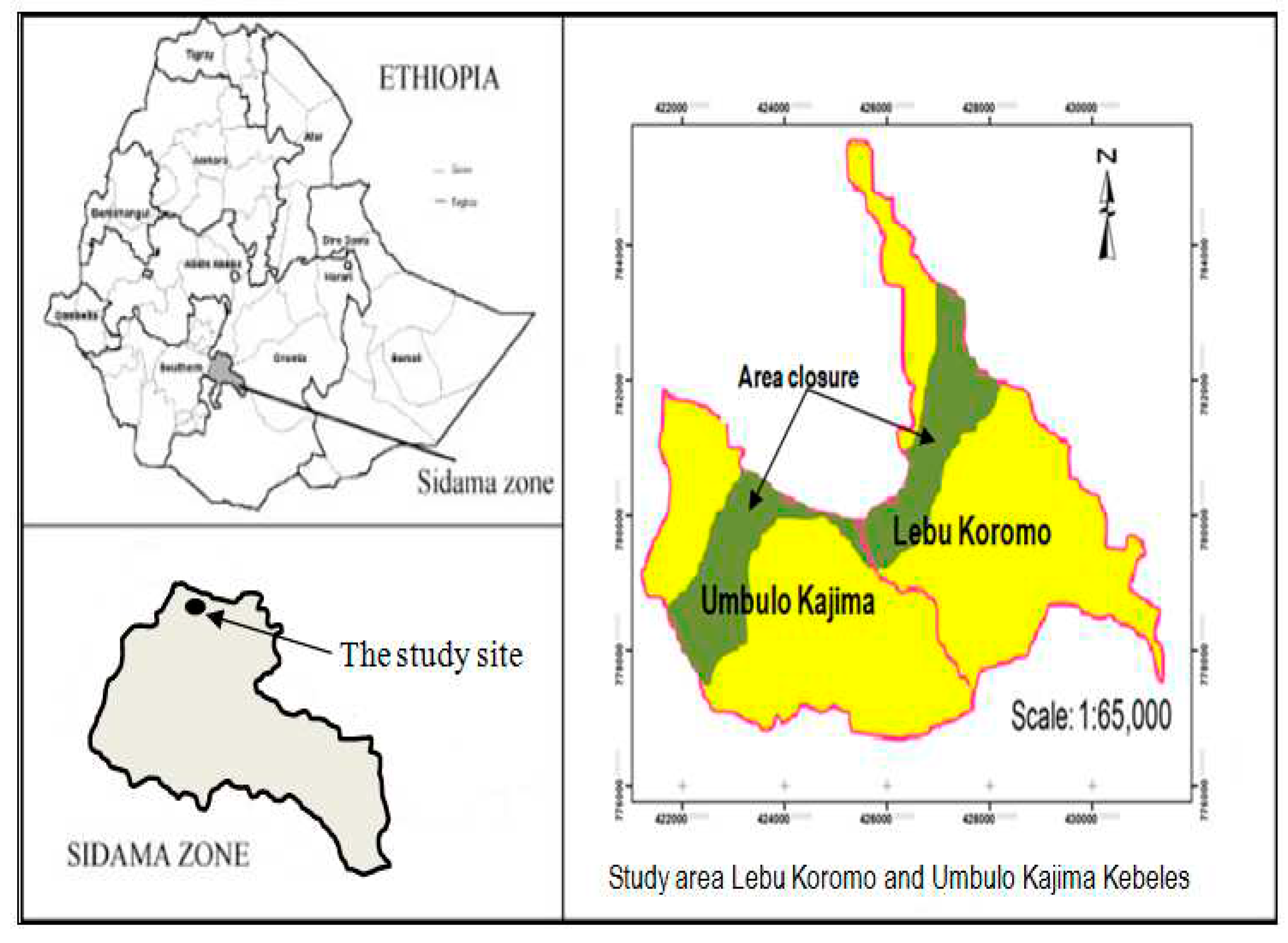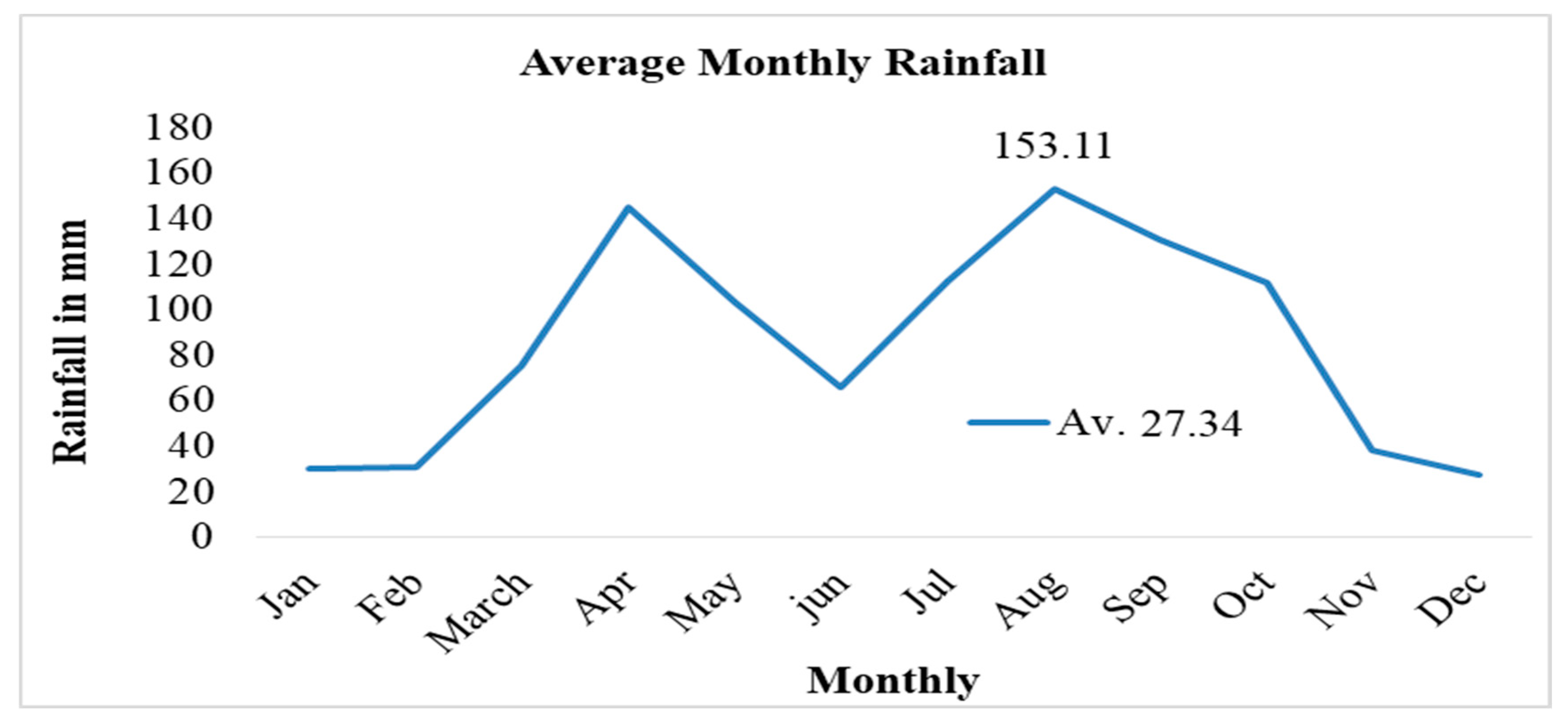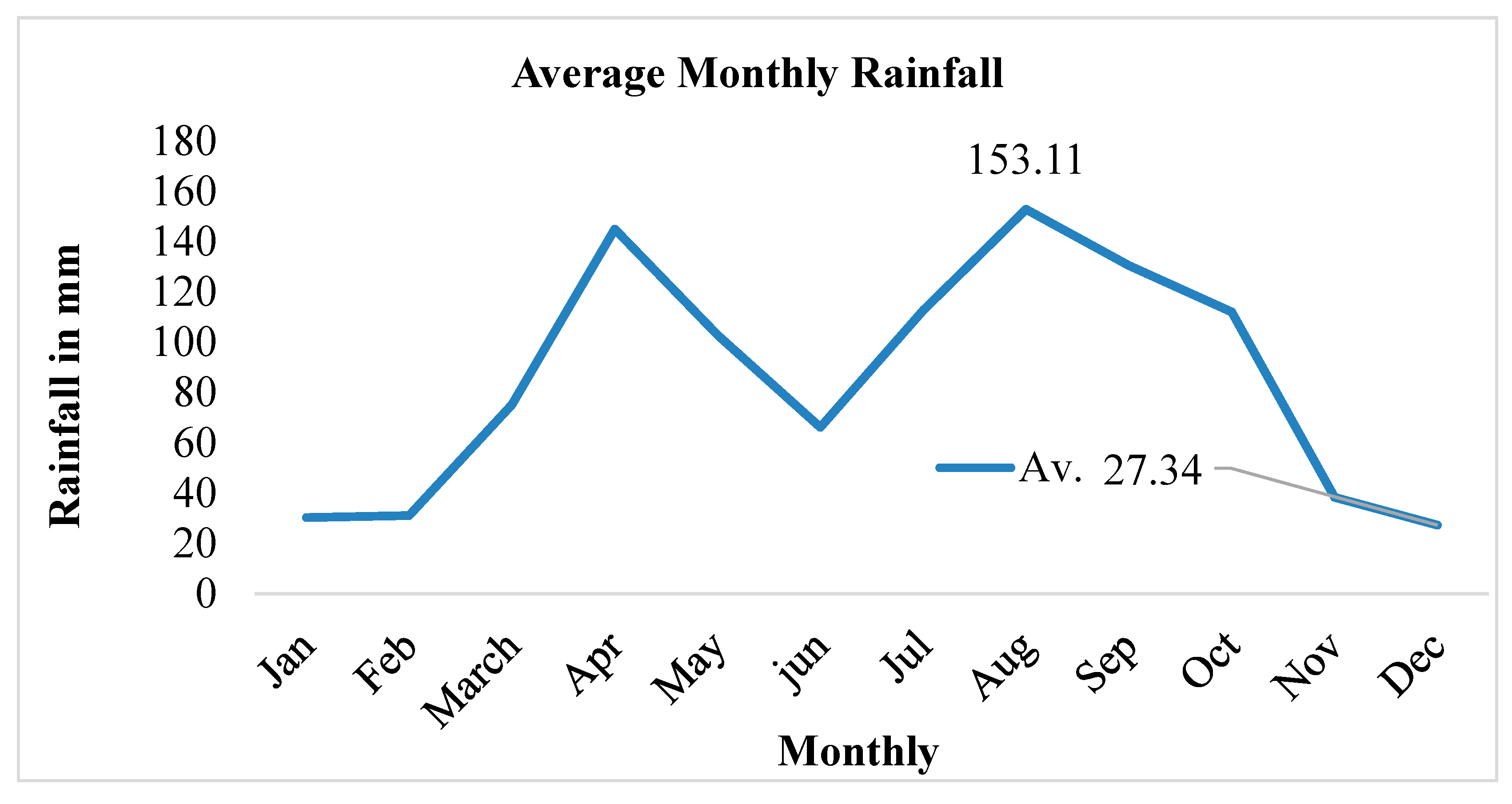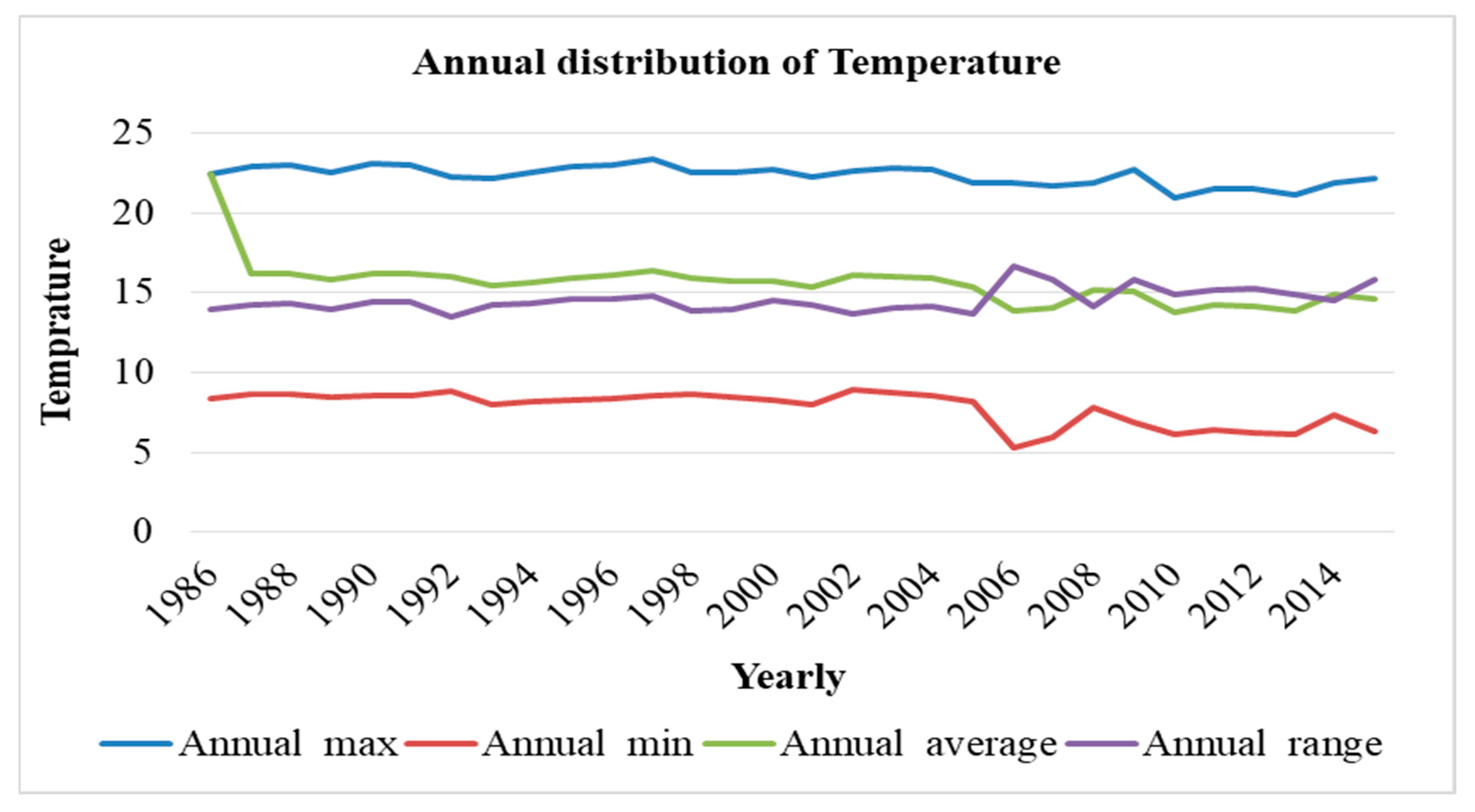1. Introduction
Climate change is one of the most immediate and complex challenges for society and economies (Hameso 2018). Climate change is likely to adversely affect the lives of poor and rural African farmers, potentially undermining food security and socio-economic development if no appropriate measures are taken (Ringler et al.2011). Farmers’ perception plays a big role for successful implementation of adaptation strategies to mitigate climate change impacts as agricultural practices concerned (Bisrat et al.2017). Raising public awareness of the real threat posed by climate change (CC) has been a common pledge in CC response policies (UNEP, 2006).In Sub-Saharan Africa, climate change and extremes such as drought are responsible for substantial economic, social and environmental destruction. Climate change, being a fundamental governance concern in recent years, appears to have largely focused on the development of global climate change regime agreements, the UNFCCC, and the Kyoto Protocol. A significant world challenge of the current century (21st) is living or adapting to climate change and climate variability. Managing the risk posed by climate change and extreme events through implementing effective technological, institutional, and policy options are crucial (Gebru et al, 2022).
The potential impacts of climate change on rain-fed agriculture strategies versus irrigated systems are not well understood (FAO 2007).Farmer’s perceptions of climate change are related to historical trends in climate (Abirham C, Zenebe M 2019)).The analysis of perception of farmers on climate variability and change of farmers showed a decline in rainfall amount, increased temperature, and shift in onset dates of rainfall, early withdrawal of rains and frequent drought occurrence. Based on the farmers perception on the other hand, the farmers’ perception of increasing or decreasing temperature was identified and in accordance with the trend of record temperature data. The farmers attributed may the cause of climate variability and change mainly to factors such as punishment from God, deforestation and increasing human population. The farmers were awarded as the impact of climate changes occurring in their area in the last decades. The farmers were indicated decreasing/ increasing diversity of cultivated mixed crops-livestock farming systems, changes in farming practices and reduction in crop livestock yields due to changes in climate patterns (Solomon et al.2016).
Climate variability and climate change are complex problems to people’s livelihoods in Africa. The expected increment in frequencies of extreme events of climate change such as droughts and floods results in agriculture will highly affect (Ebi et al., 2021). Most farmers in the research area are generally impacted by the effects of climate change and variability. The purpose of this study was to examine farmers’ perceptions to climate change and variability, and its impact in agriculture in accordance with actual recorded weather data of the Umbulo Kajima and Lebu Koromo kebeles of Dorebafana district during the time interval from 1998 to 2018. In this study, I conducted an intensive reconnaissance field survey of the two kebeles to document geographic and physical characteristics of the area as well as the various farming systems. A structured household questionnaire was employed to gather information on the area’s demographic farming profile, extant farming systems, farmers’ concerns for and perceptions of climate change, and its impact in agriculture
2. Materials and Methods
2.1. Description of the Study area
The study was carried out at Umbulo Kajimma and Labu Koromo kebeles in Dorebafana District, Sidama Regional State. Umbulo Kajimma kebele and Labu Koromo kebeles are located in (70 1’ 45’’ N, 380 16’30’’ E) and (70 6’ 30’’ N, 380 22’45’’ E). Umbulo Kajimma kebele covers 18.03km2 and Labu Koromo kebele covers 17.32km2.
Figure 1.
Map of the study area.
Figure 1.
Map of the study area.
2.1.1. Demography
According to CSA (2012) national census, the populations of Dorebafena District are estimated to 142,085 of which 71,655 are male and 70,043 are female. The total populations in the area are rural dwellers with a population density of 465.5 people per kilometer square. According to (Zakari et al.2022) the total population of study sites Umbulo Kejima kebele is 9,303 whereas Lebu Koromo kebele is 7,915.
2.1.2. Climate
In terms of agro-climatic zone, Dorebafena district falls within dry woina-dega (or mid altitude) category. There is no river that flows within the district. The only water resource available is Lake Hawassa, one of the biggest lakes within the rift valley. The mean altitude of the district is 1,700 meters above sea level and the annual rainfall ranges between 900-1400 mm. The rainy season extends from March through September. Mean annual temperature ranges from 23-270C (EMIRU, 2002).
2.1.3. Soils and Topography
Well drained deep to very deep eutric cambisol, well drained deep hablic cambisol, well to excessively drained, shallow to deep eutric cambisol are the dominant soil type and well to excessively drained, deep to very deep, medium and course textured vitric Andosols are also developed on flat to gently undulating topography and rolling plain. The major landforms identified in the study area are level plains, rolling plains, hills, elongated escarpments and mountains with slopes ranging from level to very steep slopes (0-30%) (MoWR, 2009).
2.1.4. Vegetation
The natural vegetation in the area can be described and characterized in to two distinct categories. The one is disturbed afromontane vegetation occurring at higher altitudes of the hilly slopes. The second vegetation type is the lowland acacia woodlands occurring at the lower landscape of the hilly sides. Those Woodlands in the highlands have also a remnant tree of high forest species which are sparsely available. However, Because of high population pressure and extreme land shortage these forests are seriously threated by agricultural conversion and over grazing. The major woody species dominating the area are acacia species, Albizia gummifera, Albizia schimperiana, Balanites aegyptiaca, Croton macrostachyus, Ficus sycomorus, Maytenus undata, Rhus natalensis.
2.1.5. Farming System and Socio-Economic Activities
Mixed farming is the main occupation and source of livelihood for the local communities. As average farm size is 0.5ha per house hold unemployment for youth and women are major challenges due to the male house hold head take a responsibility on this small farm land (Siders 2019). The major crops grown in the District are Maize, Barley, Teff, Haricot bean and most of the area around the homestead is covered with perennial crops mainly Enset, which is used as staple food throughout the year and income source. Coffee (mainly Coffee arabica) and chat are also widely planted. Fruit trees such as Papaya, Banana, Avocado and Mango are also cultivated. Vegetables such as potato, cabbages, onion, carrot, pumpkins and green pepper are grown intercropped either with Enset and Coffee plantation for both domestic food and income generation. Insect pests (stalk borer, cut worm); diseases (damping off, soil borne diseases, late blight, bacterial wilt) and weeds (Nech lebash) are the common problems for farming system of Dorebafena woreda. Cattle, sheep, goats, donkeys, horses and chickens are the common livestock species kept in the area (Emiru 2007).
2.2. Methods of Data Collection
Yimane (1967) formula was used to determine the required sample size with 95% confidence level, degree of variability 5% and the level of precision 8%. n= N/1+N (e) 2 Where, n = the sample size, N is the population size (the total population numbers in the three kebeles), and e is the level of precision. Both primary and secondary data sources were used to collect qualitative and quantitative data. A semi-structured questionnaire, focus group discussions (FGD), and key informants interview (KI) were used to assess primary data from 88 household surveys. In other cases, secondary data was assessed from journals, official reports, meteorological stations, NGOs, and published literature for analysis. Household survey was used to assess the perception of farmers towards the trend of changes and variability in the local climate in the past 30 years, adaptation strategies of farmers in the face of climate change and variability, and key factors to adapt, as well as socio-economic and demographic characteristics of respondents and institutional accessibility that were included in the questionnaire. In Focus Group Discussion (FGDs), the members were selected from different social groups by using purposive sampling methods. The discussions were prepared on open ended questions and it conducted on three groups, each consisting of 10 participants. The selection of the group members were focused on by assumed their skills, experiences and knowledge about the research topics. Key informants were interviewed detailed and general knowledge to complement the data obtained from sampled households’ survey and focus group discussions for better understanding. Secondary data were collected from various documents of offices in the Umbulo Kajimma and Labu Koromo kebeles of Dorebafana districts, such as reviews of literature, available articles, thesis, official reports, publications, and websites
2.3. Data Analysis
Descriptive statistics and tabular presentations including graphs, percentages, charts, tables, and maps, were used to characterize farmers’ perceptions of climate change and variability. Furthermore, for quantitative data analysis, the SPSS version 20.0 and MS Excel 2007 were used to characterize farmers’ perceptions on climate changes and variability, and its impact in agriculture. The data gained from key informants’ household’ interviews and focus group discussions were analyzed and described through opinion interpretations after the data was sorted out and organized by using descriptive statistical analysis.
3. Result and Discussion
3.1. Climate Data in the Study Area
Key informant interviews and focus group discussions revealed that, most of the time, climate change and/or variability were observed in terms of precipitation and temperature in the study area. Respondents in the study area were faced with feeling the change in temperature, the change in the amount of rainfall, the rain season was late than normal, increase of temperature and occurring early rain season than normal were the main effects of climate change in the study area (Shown in below
Table 1).The district has limitations in different ways, it has many missing values (many months had no recording data) both for precipitation and temperature, it follows a poor recording system and it has no records for all agro-ecological zones. For such limitation, the missing data of temperature and precipitation were corrected by taking daily and average for rainfall and maximum and minimum for temperature.
Table 1.
Farmers Perception on climate change.
Table 1.
Farmers Perception on climate change.
| |
|
Number of Respondents |
Percentage (%) |
| No |
Perceptions |
Respond-
dents |
I Don’tKnow |
No |
Yes |
Yes, Very Much |
I Don’t Know |
No |
Yes |
Yes, Very Much |
| 1 |
Is there climate change occurred |
88 |
2 |
22 |
38 |
26 |
2.2 |
25 |
43 |
29 |
| 2 |
Do you feel the temperature of the area is changing |
88 |
4 |
32 |
30 |
22 |
4.54 |
36 |
34 |
25 |
| 3 |
Is there change in amount of rainfall is occurred in the main season |
88 |
8 |
34 |
40 |
6 |
9.9 |
38 |
45 |
6.8 |
| 4 |
Is there season of rain is late than normal in the study area? |
88 |
10 |
25 |
40 |
13 |
11 |
28 |
45 |
14 |
| 5 |
Has time of onset of rain is shifted in main season? |
88 |
10 |
42 |
32 |
4 |
11 |
47 |
36 |
4.54 |
| 6 |
Do you feel the temperature of the area is increasing?
|
88 |
3 |
8 |
44 |
33 |
3 |
2.2 |
50 |
37 |
Figure 2.
Annual rainfall.
Figure 2.
Annual rainfall.
Figure 3.
Average Monthly Rainfall.
Figure 3.
Average Monthly Rainfall.
Figure 4.
Annual distribution of Temperature.
Figure 4.
Annual distribution of Temperature.
3.2. Farmers Perception
Perception of farmers on climate change and climate variability was observed in the study area, because most of them have been feeling changes in amount of precipitation, onset and offset of rainfall, increasing temperature and occurrence of frequent drought. Farmers were highly perceived in changes on rainfall and temperature in the study area (Shown in below
Table 1). The result shows that most of the respondents, about 72% aware that there was change in climate, 25 % respondents were perceived that there was no change in climate and 2.2% of the respondents did not know about climate change in the study area. Also, 59% of the respondents feel the temperature of the study area was increasing in the past 30 years, while 36% of them observed that they were not aware of temperature change or they did not feel change in temperature in the study area for the past 30 years.
Moreover, 51.8% of the respondents perceived as increased rainfall amount in the last three decades in the study area, whereas 38% have observed a decreased in the amount of rainfall and 9.9% of the respondents were did not know about the amount of rainfall in the study area (
Table 1).
In general, about 74.7% of the sampled households of the study area have perceived change on in amount of rainfall in the past 30 years weather there was increase or decrease of rainfall. As group discussion and key informants have crosschecked in the study area, the change was not only in the total amount of rainfall but there was also observed in time of rains, withdraws before normal time and entering rain was later or earlier than expected season. The result indicated that about 64.4% of the respondents perceived the late starting of the rainfall from normal season and respondents observed the late starting of rainfall from normal date, about 61.7% of the respondents observed the onset of rain season shifted from normal date and about 54.4% of the respondents have observed the early ending of the rain season from normal date in the study area.
3.3. Impacts of Climate Change in the Study Area
Farmers in the study area were observed climate change impacts in many cases, and they have faced challenges in their farm activities for the past 30 years. The result shows that about 61% of the respondents were recognized that the occurrence of drought or increase of drought in the past three decades in the study area (
Table 2). About 49% of respondents have observed in the area as they have faced with a complete crop failure in the past 30 years in their agricultural activities. About 71% of the households have noticed that the amount of precipitation in the study area was not sufficient for crop cultivation and livestock in the past 30 years. As group discussion and key informants have recognized that households in the study area also encountered with a problems of temperature, rainfall, shifting of season from normal, drought frequencies and complete crop failures. The sampled households indicated that about 54% of respondents were perceived as there was the occurrence of the human health problems due to climate change and 48.7% of the respondents were observed as there is the increment of livestock problems related to climate change in the study area. This finding is agreed with the study of (Balasundram
et al., 2023), which stated that, climate change brings significant impacts on livestock production system. The respondents were also approved that farmers faced in the study area due to climate change with new emerged diseases and the shortage of food, and their income which come from agriculture is become decreasing from starting in the past 30 years. And they concluded that climate change was one of the most common problems for households in the study area.
Table 2.
The impacts of the climate change.
Table 2.
The impacts of the climate change.
| No. |
Impacts |
Respon-
dent |
I Don’t Know |
No, There Is No |
Yes |
Yes Very Much |
Percent (%) |
| I Don’t Know |
no, There Is No |
yes |
Yes Very Much |
| 1 |
Human health problem due to climate change |
88 |
10 |
30 |
38 |
10 |
11 |
34 |
43 |
11 |
| 2 |
Is there occurrence of drought? |
88 |
10 |
24 |
44 |
10 |
11 |
27 |
50 |
11 |
| 3 |
Livestock health problem occurred |
88 |
12 |
34 |
30 |
14 |
13 |
38 |
34 |
15 |
| 4 |
Is there complete crop failure? |
88 |
8 |
36 |
36 |
8 |
9 |
40 |
40 |
9 |
| 5 |
Sufficient of precipitation for cropping |
88 |
10 |
30 |
40 |
8 |
11 |
34 |
45 |
9 |
4. Conclusions and Recommendation
This research was conducted to identify farmers’ perception and their adaptation strategies to climate change and/ or variability impacts in Umbulo Kajimma and Labu Koromo kebeles in Dorebafana District based on the past 30 years data that was recorded on rainfall and temperature from National Meteorology Agency (NMA) and cross-sectional survey data collected from 88 sampled of households from the total population of the selected kebeles.
The study was mainly conducted in three kebeles of the district based on its agro ecological zones (highland, midland and lowland). In the study, descriptive statistics and multinomial logistic regression model were used to analysis farmers’ perception and factors affecting choice of adaptation strategies to adverse impact of climate change in the study area in the past 30 years. Farmers in Umbulo Kajimma and Labu Koromo kebeles in Dorebafana District perceived the long-term change in rainfall and temperature patterns. They can identify the rate of drought has increased and the pattern of rainfall has become not seasonal over the last 30 years. The finding conducted that, the amount of rainfall in the study area in the past 30 years was decline and highly variable. The finding also concluded that, change and increment of temperature was one of the main problems that farmers were faced with climate change impacts in the past 30 years in the study area. Based on the findings it is advisable to build farmers perception and their adaptation strategies to tackle the adverse effects of climate change in the study area by creating awareness of farmers about climate change in the way of giving short term training, information by different means of media, increase their educational level, maximizing the chance of extension service and make them as they sharing experience to each other in the form of field visit.
References
- Abirham C, Zenebe M (2019) Comparing Farmers Perception of ClimateChange and Variability with
Historical Climate Data: The Case of Ensaro District, Ethiopia. Int J Environ Sci Nat Res 17(4): 555-966.
- Balasundram S.K., Shamshiri R.R., Sridhara S. and Rizan N., 2023. The Role of Digital Agriculture in Mitigating Climate Change and Ensuring Food Security: An Overview. Sustainability, 15(6), p.5325.
- Bisrat K, Gizaw M, Gerrit H (2017) Climate risk management climate change and population growth impacts on surface water supply and demand of Addis Ababa, Ethiopia. Clim. Risk Manag 21-33.
- Ebi K.L., Vanos J., Baldwin J.W., Bell,J.E., Hondula D.M., Errett N.A., Hayes K., Reid C.E., Saha S., Spector
J. and Berry P., 2021. Extreme weather and climate change: population health and health system
implications. Annual review of public health, 42(1), pp.293-315.
- EMIRU BIRHANE, TEKETAY, D. & BARKLUND, P. (2007). Enclosures to enhance woody species diversity in the dry lands of eastern Tigray, Ethiopia. East African Journal of Sciences, 1, 136-147.
- EMIRU BIRHANE. (2002). Actual and potential contribution of Enclosures to Enhance biodiversity in dry lands of eastern Tigray With particular in woody plants. Msc Thesis. Swedish University of Agriculture (SLU).
- Gebru Hadgu, Kindie Tesfaye, Girma Mamo and Belay Kassa., 2015. Farmers‟ climate change adaptation
options and their determinants in Tigray Region, Northern Ethiopia. African Journal of Agricultural
Research, 10(9): 956-964.
- Hameso S (2018) Farmers and policy-makers’ perceptions of climate change in Ethiopia. Clim Dev 10(4), 347-359.
- Ringler C, Bryan E, Hassan RM, Alemu T, Hillesland M, et al. (2011) How canAfrican agriculture adapt to climate change? Insights from Ethiopia and SouthAfrica. IFPRI Washington, DC.
- Siders A.R., 2019. Adaptive capacity to climate change: A synthesis of concepts, methods, and findings in
a fragmented field. Wiley Interdisciplinary Reviews: Climate Change, 10(3), p.e573.
- Solomon Addisu, Getachew Fissha, Birhanu Gediff and Yemane Asmelash. 2016. Perception and
adaptation models of climate change by the rural people of lake Tana Sub-Basin, Ethiopia. Environmental
Systems Research, 5(1): 7.
- Yamane T. 1967. Problems to accompany" Statistics, an introductory analysis". Harper and Row.
- Zakari S., Ibro, G., Moussa B. and Abdoulaye T., 2022. Adaptation strategies to climate change and impacts on household income and food security: Evidence from Sahelian region of Niger. Sustainability, 14(5), p. 2847.
|
Disclaimer/Publisher’s Note: The statements, opinions and data contained in all publications are solely those of the individual author(s) and contributor(s) and not of MDPI and/or the editor(s). MDPI and/or the editor(s) disclaim responsibility for any injury to people or property resulting from any ideas, methods, instructions or products referred to in the content. |
© 2023 by the authors. Licensee MDPI, Basel, Switzerland. This article is an open access article distributed under the terms and conditions of the Creative Commons Attribution (CC BY) license (http://creativecommons.org/licenses/by/4.0/).








